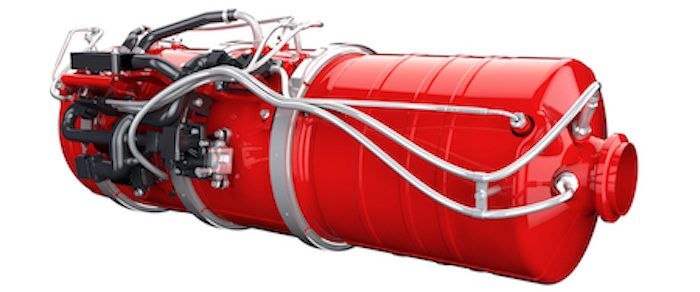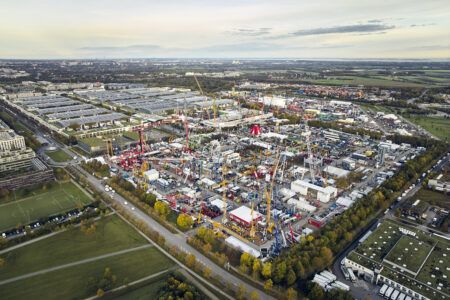While some experts claim that fossil-fueled engines are finished and that industrial vehicle OEMs must look to electricity to provide motive power, the unique demands of the market suggest otherwise. Off-highway vehicles must function in virtually every corner of the globe and need to drive agriculture and construction projects at a speed to cater for predicted worldwide population expansion from 7 to 11 billion by 2100.
But that doesn’t mean the world must accept a future of heavy pollution. Currently, we have cleaner, more efficient diesel products in the market than most would have believed possible a decade ago. iVT takes a look at how we got here, and what the future holds. The West only started looking at emission control during the 1970s and 1980s. Back then, the emphasis was on carbon dioxide and unburned hydrocarbons present in the exhaust gases; engines at the time were, by modern standards, pretty inefficient. Progressively improving the combustion efficiency resulted in more complete ‘burn’ of the fuel, but the increases in combustion temperature started to result in the production of oxides of nitrogen (NOX), which posed a different issue and is the gas one hears most about at the moment.
Most manufacturers installed exhaust gas recirculation (EGR), whereby a portion of the exhaust gas was cooled and reintroduced into the air entering the engine. “Cooled EGR systems take some of the used exhaust gas, cool it, and then mix it with the intake air as it goes into the engine,” says Steve Nendick, off-highway communications director for Cummins. “EGR actually gives
you lower combustion temperatures, which reduces NOX but increases particulate emissions. There is a trade-off between the two.”
As OEMs progressed their machines through the subsequent levels of control, other systems were added. A big turning point was the inception of electronically controlled fuel injection, enabling an engine controller to monitor exhaust reactions and adjust the combustion accordingly.
Catalysts became necessary around Stage III and IV (i.e. DOC – diesel oxidation catalyst). Then, most recently, ammonia injection (selective catalytic reduction and diesel exhaust fluid, SCR and DEF) and diesel particulate filters (DPF) were adopted.
During this period, the constantly changing profile of the engine equipment envelope posed the biggest challenge to OEMs.
Progressing through Euro Stage I to IV has required more and more resources, many of them to do with packaging issues. Different engine manufacturers have fulfilled different needs at different stages, with one UK-based OEM, who wished to remain anonymous, having used three already: CNH (Stage I-II; Perkins (Stage II-III); JCB (Stage III-IV). It is now looking to its fourth, Volvo, for Stage V.
Although serious emission control for internal combustion engines originated in the Americas, there has been a noticeable dilution of the demands from the US Environmental Protection Agency in the recent past. So, while European OEMs speculate the prospect of further controls beyond Stage V, the US Environmental Protection Agency has no plans to follow through to Tier 5 and in fact seem unlikely to push for tighter controls beyond Tier 4 Final. Tier 4 Final is roughly equivalent to Euro Stage IV which is after all a substantially effective control level. One could speculate that with the position taken by the current US administration on environmental issues, any further movement towards more stringent emission controls will be ostensibly curtailed.
Stage V added a finer particulate specification and a size count, but from the engine hardware/control point of view, much of the technology was in place at Stage IV. This gave engine manufacturers the chance as they moved their product to Stage V to look at the issue of system packaging, optimizing in some ways and compromising in others to better accommodate the true demands of the OEM. For example, Cummins and Perkins have moved away from EGR in their systems in favor of simplified aftertreatment. Many, though, including John Deere, still cite EGR as a useful system. On its PowerTech range, John Deere plays the variables of NOX versus particulates against aftertreatments. Units employing EGR can be configured to use smaller catalysts than DEF systems but with a particulate filter, while non-EGR models need no particulate filter but do need larger catalysts with higher DEF usage. John Deere Power Systems’ marketing communication coordinator, Sandrine Alem, explains, “Cooled EGR used in John Deere engines increases the effectiveness of NOX reduction while enhancing engine efficiency. Engines with cooled EGR and a DPF are calibrated for improved total fluid economy, both diesel fuel and DEF.”
Deutz and MAN have emphasized flexibility by componentizing the aftertreatment modules. MAN, in particular, has worked from a position of strength on Stage V as the company already participated developing Euro 6 compliance for the commercial truck market and knows that all OEMs have the same basic demand: minimum disruption to their vehicle envelope. Like Deutz, it retains EGR and concentrates on componentized aftertreatment to fit the product to the job. Florian Schaffelhofer, head of external relations for MAN, comments, “It is not possible just to put our AGN [Abgasnachbehandlung /exhaust gas aftertreatment] onto a Stage IV engine to achieve Stage V, since data sets of the engines are different and the engines use different internal technology. However, connecting dimensions of the engine are always the same, which is an important advantage for the OEMs. The concept of MAN Engines is the provision of dimensionally identical engines to fulfill different emissions standards using different data sets and exhaust components (DOC/DPF, SCR, EGR) depending on the power rating and engine series.”
In the same way, the Deutz DVERT system comprises a modular system of aftertreatment modules that are not model specific and can be applied over a broad range of the company’s products.
Critics of EGR cite the fact that the recycled gas is counterproductive as it has a lower oxygen content than clean air and therefore is less efficient in practical terms. Although some manufacturers have added technology to address Stage V demands, Cummins and Perkins have taken an alternative route and rationalized their aftertreatment by removing EGR and combining particulate filters with SCR and DOC systems in one module.
Steve Nendick elaborates on the Cummins offering: “The latest Single Module aftertreatment technology is smaller and lighter than at Stage IV. Our EGR-free engine designs are compact with less weight and single module aftertreatment designs require less space. Using the Holset VGT [variable-geometry turbocharger] we also achieve exceptional power density with fuel-efficient performance.” Perkins, meanwhile, emphasizes efficiency for Stage V. Its new four-cylinder Synchro is a 2.8- and 3.6-liter line-up ranging from 45-100kW (60-134hp). A full aftertreatment package is available including both DOC and DPF to cover the lower-rated engines with the addition of an SCR above 70kW. Of note here is the contrast in power ratings for these engines versus prior offerings. These Stage V engines achieve power ratings of up to 100kW on a four-cylinder engine with 3.6-liter configuration. The lower power variants have only 0.7-liter/cylinder swept volume.
A decade ago, swept volume would have been almost double and we would be looking at a six-cylinder configuration once we tipped over the 75kW (100hp) mark, so it is clear where some of the emission reductions come from. The engines are just burning less fuel and doing it a lot more efficiently.
However, you don’t always need complicated aftertreatment and extensive filtering just to conform to Euro Stage V. At scarcely more than half a meter high (19.6in) and just over 400mm (15.7in) wide, the Perkins 402D-05 engine has an installation envelope of 0.7m3 (24.7ft3) and is likely to satisfy the installation requirements of the many OEMs operating in its power class. Knocking out a useful 10.2kW (13.7hp) from an in-line two-cylinder configuration of just over 500cc, this unit is mechanically governed with an indirect injection system, with absolutely no aftertreatments. Duncan Riding, technical sales manager at Perkins, explains why this is possible: “Engines smaller than 19kW [25.4hp] are controlled, but not to the same level as larger units. Emission limits are calculated based on grams of NOX per kW, per hour of running time. Small equipment has low power, lower average load factors and generally lower annual running hours.” So at least at this level OEMs currently have a practical unit that installs without any complications. It is clear that, for some companies, Stage V is the end of a long story of expense and investment, which many endorse as necessary to save the environment. But it is worth noting that much of the future worldwide population growth (and therefore growing markets for OEMs) is predicted in semi-developed and developing nations of the world, which do not currently have such stringent emissions regulations.
Tightening emissions controls on off-highway vehicles in developing nations will directly affect the cost of the machines, which will slow down the investment in the sector, slowing economic growth.
Governments might do well to consider that, for the time being at least, engineering companies in the West have made their contribution and it is time that a comprehensive agenda on the impact of diesel emissions worldwide is properly formulated – and hopefully adhered to.





